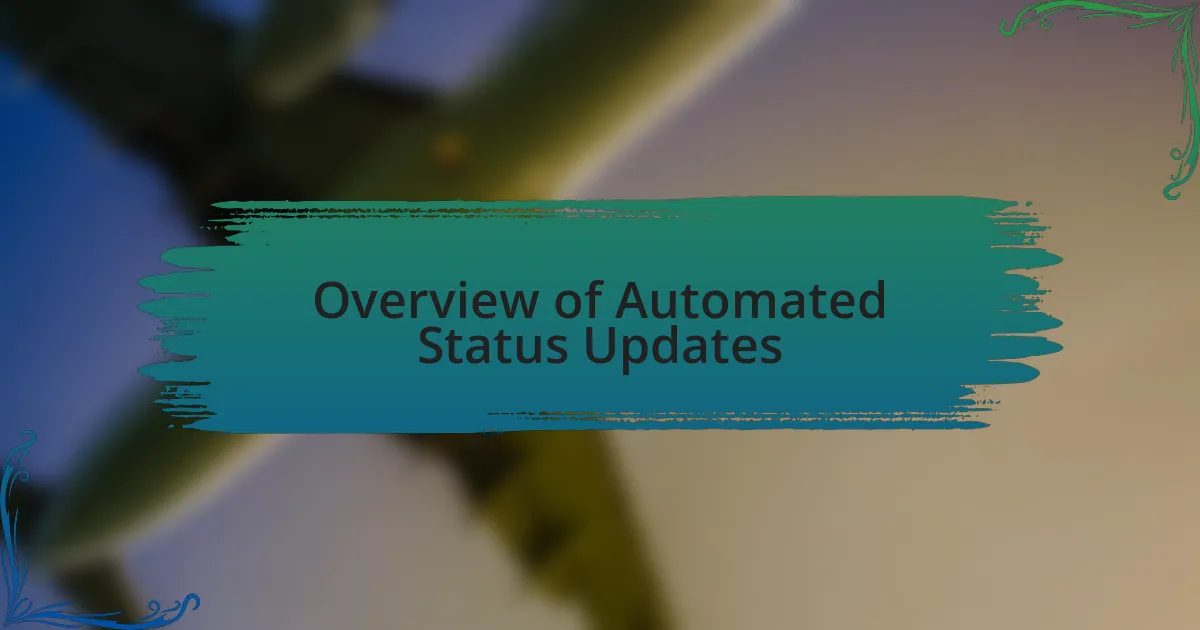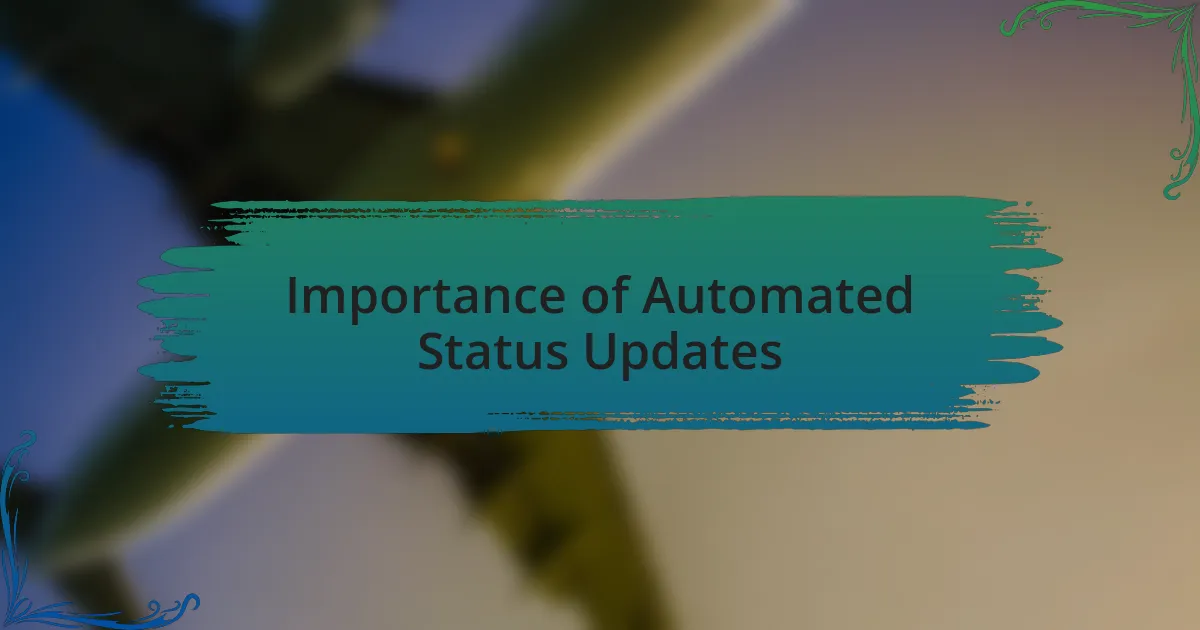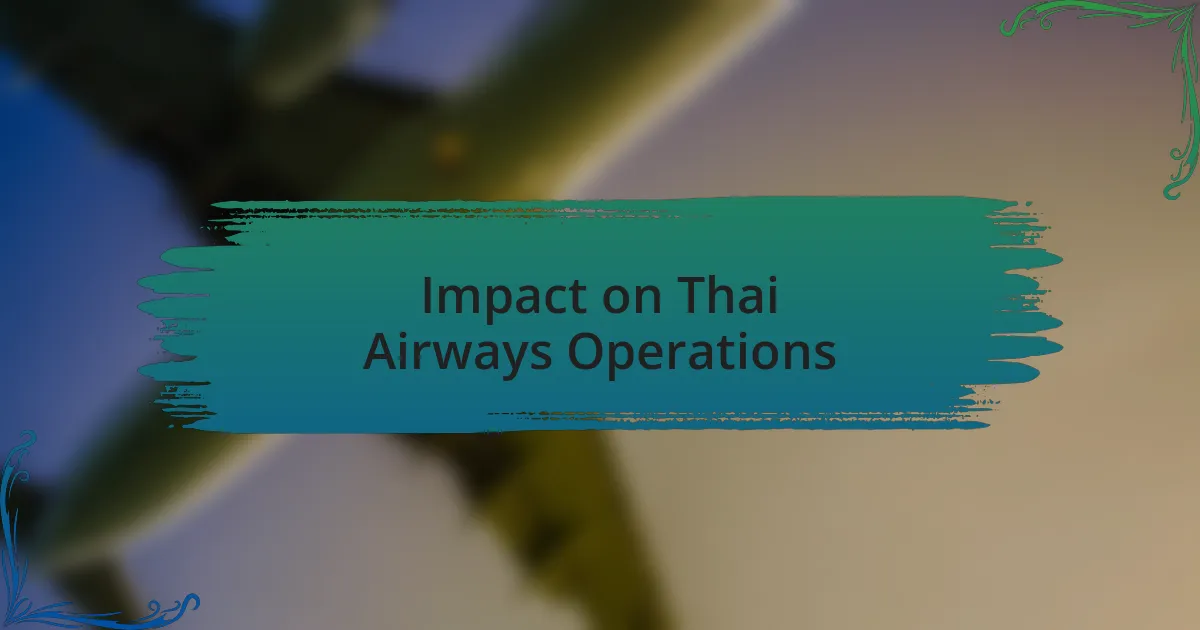Key takeaways:
- Automated status updates enhance passenger communication, reducing anxiety and fostering trust between airlines and travelers.
- These updates provide convenience, helping passengers manage their time effectively and feel valued by the airline.
- The implementation improves operational efficiency for airlines like Thai Airways, allowing better resource allocation and accountability.
- Suggestions for improvement include increasing update clarity, integrating passenger feedback mechanisms, and simplifying notification language.

Overview of Automated Status Updates
Automated status updates have transformed how airlines, including Thai Airways, communicate with passengers. I recall the last time I flew – receiving real-time updates via text was a game changer. It made me wonder how much easier travel can be when we’re kept in the loop.
Think about the anxiety that comes with waiting at the airport for essential flight information. Automated updates take away that stress by providing timely alerts about delays, gate changes, or check-in reminders. This kind of transparency not only enhances the travel experience but also builds trust between the airline and its passengers.
Moreover, these updates are not just about conveying information; they’re about creating a connection. When I receive a notification, it feels personal, like the airline is looking out for me. By using automated systems, Thai Airways can ensure that passengers feel valued and informed, paving the way for a smoother travel journey.

Importance of Automated Status Updates
The significance of automated status updates cannot be overstated. For instance, I vividly remember a time when a sudden storm delayed my flight. Without automated updates, I would have been left in the dark, anxiously glancing at departure boards. Instead, I received a text update that let me know my flight was postponed, allowing me to grab a coffee and relax instead of stressing out.
These automated messages foster not only convenience but also a sense of security. As a frequent flyer, I cherish the peace of mind that comes from knowing I’m always informed. It’s comforting to be notified about a change before I even reach the airport. Have you ever felt lost in uncertainty while waiting for flight information? Automated updates minimize those moments, keeping passengers in the loop and enhancing overall satisfaction with the travel experience.
Furthermore, the emotional pull of receiving timely information can’t be ignored. I’ve often felt gratitude when a simple notification pops up on my phone, reminding me that I’m not just another passenger but a valued customer. This human touch, powered by technology, speaks volumes about how airlines like Thai Airways prioritize their passengers’ comfort and assurance.

Benefits of Using Automated Updates
Automated updates offer incredible time savings for passengers, allowing them to plan their travel more efficiently. I recall a time when I was able to reroute my airport arrival after an automated message informed me of a gate change. Rather than frantically rushing to the wrong terminal, I had enough time to grab a quick bite, making my travel experience far less stressful. Isn’t it a relief to avoid those last-minute scrambles?
In addition to saving time, these updates also enhance customer engagement. When I receive a message about a flight delay or change, it feels like the airline is actively communicating with me. This personal touch helps maintain a connection that’s often lost in the hustle and bustle of travel. Can you imagine the difference it makes to feel like you’re part of the conversation, rather than just a number?
Moreover, the reliability that comes with automated updates fosters trust in the airline. For instance, during a recent trip with Thai Airways, I appreciated receiving real-time updates even before I reached the airport. With each notification that arrived, I felt more assured that the airline was on top of any situation. How often do we weigh our choices in airlines based on how well they keep us informed? That level of reliability not only enhances the flyer’s journey but also solidifies brand loyalty in an industry where competition is fierce.

Impact on Thai Airways Operations
The implementation of automated status updates significantly streamlines Thai Airways’ operations. I remember a specific instance when a last-minute technical issue arose before my flight. Thanks to the automated system, I received timely notifications about the situation, which allowed the ground staff to manage the boarding process more smoothly and efficiently. Wouldn’t it be great to see more airlines adopt such proactive measures to minimize chaos?
Additionally, these updates have proven invaluable in optimizing staff allocation. By knowing in real-time about changes in flight schedules, Thai Airways can better deploy its resources where they’re needed most. I’ve often seen how a well-informed crew can enhance the overall travel experience, making everything run like clockwork. Isn’t it comforting to think that a simple text update can lead to a more organized and less stressful atmosphere at the airport?
Moreover, incorporating automated updates fosters a culture of accountability within the airline. I once witnessed a situation where a flight was delayed due to weather conditions, but the constant updates not only kept passengers informed but also held the airline accountable for managing our expectations. It’s intriguing how transparency through technology can lead to a more respectful relationship between passengers and the airline, don’t you think?

Suggestions for Improvement
One area for improvement could be the frequency and clarity of the updates. There have been moments when I was left wondering about my flight status despite receiving notifications. If Thai Airways could provide more consistent messaging, it would not only enhance clarity but also reduce anxiety for travelers. Wouldn’t it be reassuring to know exactly when to expect the next update?
Another suggestion is to integrate a feature that allows passengers to provide feedback on the automated status updates. I’ve often felt that a simple survey after a flight could give the airline valuable insights into what worked and what didn’t. Engaging passengers this way not only fosters loyalty but also improves the service by ensuring their voices are heard. Isn’t it important for an airline to be in tune with its travelers’ needs?
Lastly, enhancing the user interface of the update notifications would make a significant difference. I recall struggling to interpret some of the messages, especially when they included technical jargon. Simplifying the language used in alerts, along with visual components like icons, could better cater to all passengers, ensuring everyone feels informed and understood. Why not make the experience seamless for everyone?